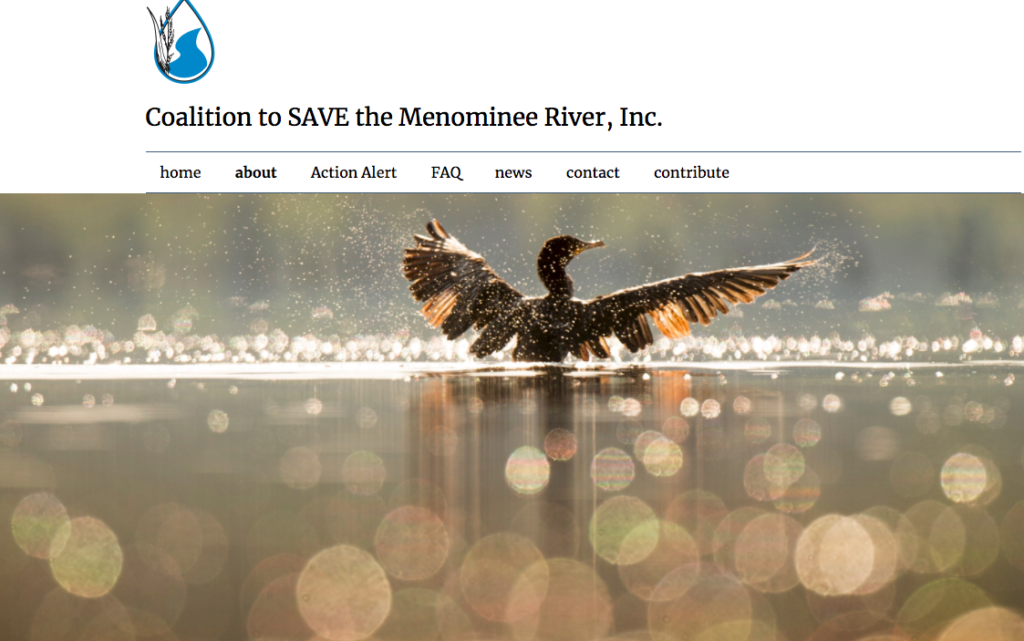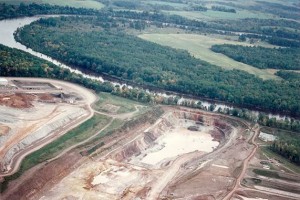Guest article by John Engel
The Coalition to Save the Menominee River was created on April 7, 2017. The coalition was created by a group of Michigan and Wisconsin residents who live near the proposed Aquila Back Forty mine or downstream of the mine site on the Menominee River. The purpose is to collectively focus their needs of representation in order to vocalize their concerns. The elected representatives are not listening to their constituents about the damage the Back Forty Mine will do to the environment, the reduction of their property value, and how it will affect the long term economic benefits of a clean Menominee River. The Coalition applied and has received 501(c)(3) and tax exempt status.
BACKGROUND – AQUILA BACK FORTY PROPOSAL
A private water well was drilled early in 2001 and zinc-rich minerals were discovered. Follow-up drill testing of the geophysical anomaly resulted in the discovery of a massive sulfide deposit containing Gold, Silver, Copper, Zinc, and Lead.
- To date, over 500 diamond drill holes have been drilled over 125,000 meters in which polymetallic ore minerals has been verified from the surface to depths exceeding 700 meters.
- Rumors of large mineral deposits and possibly an open pit mine were common until 2006 then the exploratory drilling activity subsided, as well as the rumors.
- Unbeknownst to the general public, Mineral Processing began purchasing land, acquiring mineral rights beginning in 2003.
- In 2010, the name changed to Aquila Resources which owns 580 acres of land adjacent to the Menominee River near the Shaky Lakes in the Upper Peninsula of Michigan.
- In 2007, Environmental Resource Management was contracted to conduct an Environmental Baseline Study and Aquila Resources was quietly proceeding with the environmental site work and engineering to obtain mining permits.
- On November 12, 2015 Aquila submitted their proposals for the mining permits. The project was quietly moving forward until the August Menominee County Journal article stating the Michigan Dept. of Environmental Quality found the application to mine was administratively complete with a public hearing in October of 2016.
As of this writing, Aquila has been granted three of four final permits by Michigan’s Department of Environmental Quality (DEQ): the Nonferrous Metallic Mineral Mining Permit, the Air Use Permit to install, and the Pollutant Discharge and Elimination System Permit. These permits have been granted, but each permit has many pages of conditions attached which have to be met prior to the permit being effective.
WETLAND PERMIT CONTROVERSY
The Wetlands Permit application was submitted and withdrawn in 2016 by Aquila, and resubmitted in 2017. On January 23, 2018 the Michigan DEQ held a public meeting in the Stephenson Michigan High school. The purpose of the public meeting was to gather public opinion regarding the proposed Back Forty Mine Wetland Permit. The number of attendees exceeded 300 with 4 people speaking in favor of the mine and 84 opposing the mine. The Wetland Permit announcement (of decision) was scheduled for April 9, 2018; however the date has been delayed. Michigan DEQ allowed the public to submit written comments on the mine until February 2, 2018 at which time they received greater than 3400 comments and requests for additional information. In response to the public comments, the Michigan DEQ has submitted a 34 page letter of questions to Aquila Resources to verify inconsistencies in their wetland permit application. Aquila has 20 days to respond to the letter which was dated March 2, 2018. The response from Aquila is required before the Michigan DEQ can make a decision on the wetlands permit. If the wetlands permit is issued, site specific conditions will likely have to be met before the wetlands permit is deemed effective.
GROWING OPPOSITION TO BACK FORTY PROJECT
On March 1st, the author traveled to a Coalition to Save the Menominee River meeting. The meeting was held in the Wagner Town Hall on the Wisconsin side of the Menominee River near the McAllister Bridge. Surveys were handed out to a number of the people attending who lived on the river or near the proposed mine site.
The chairman of the group, Dale Burie, opened the meeting with a prayer for the river and the attendees. Dale proceeded with the agenda, providing updates on the Wetlands permitting process, the Menominee Nation’s Clean Water Act federal lawsuit, a treasurer’s report, various public events opposing the Back Forty Mine, future fund raising events, the lack of objective journalism by the Marinette Eagle Herald newspaper, and the lack of representation by their elected officials. Approximately 40 people attended the meeting. After the meeting, I met with each of the people who completed the survey. The news media, industry, and environmental organizations tend to focus on job creation or environmental harm; I propose we meet a few of the people who will be most affected by the Back Forty Mine.
CONCERNED CITIZENS
Dennis and Andrea Piontek retired 2 ½ years ago and live in their retirement home. They worked and saved to build their dream house on river 10 miles downstream of the proposed mine. Prior to building, they saw some signs about a mine but they were assured the investors backed out and the mine was a non-issue. Dennis and Andrea enjoy nature, clean air, clean water, and the variety of bird life. Andrea told me about the eagle family that lives in the area. Dennis enjoys fishing in the river and the fish are currently safe to eat. They are both very concerned about the river being polluted and the destruction of habitat. Another issue is property values, their home valuation has dropped which they believe is a direct result of the proposed mine activity.
Regina Chaltry and her daughter Gracey spend time at their family cottage south of the Oxbow on the Michigan side of the river. The cottage has been in their family since the 1940’s. They enjoy the quiet solitude and harmony with nature at their cottage. This area is beautiful, completely surrounded by forests, it is nearly untouched. They haven’t brought in electricity, opting for a simplified lifestyle. As a family, they enjoy floating down the river. They see eagles, deer, pheasant, porcupine, and beaver; in the evening owls are often heard. The spring ritual of collectively tapping and making maple syrup is an annual event. Regina and her family are very concerned about toxic mine waste polluting the Menominee River and prohibiting them from enjoying their family’s lifestyle.
August Beres has lived on the Wisconsin side of the river for more than 50 years. Augie dreamed about living on the river since he was a teenager. He worked hard saved his money, and his dream came true. When Augie’s grandchildren visit, they fish, canoe, and play in the river shallows. He is gravely concerned that if Aquila is allowed to mine, there will be a breach in the mine or another unforseen disaster. His grandchildren will not be able to grow up enjoying all the recreational and environmental opportunities river has to offer. Augie has written letters to our Governor, both U.S. Senators, U.S. Congressman, State Senator, and State Assemblyman. Augie received some positive feedback from State Assemblyman Jeff Mursau; however no serious action to alleviate his concerns has occurred. Tom Tiffany said the proposed mine was in Michigan and there was nothing he could do.
Tina Lesperance lives on the family farm which is approximately one mile east of the proposed mine site. Currently, the Aquila employees who work at the field office drive past her farm on their way to work. Tina’s farm has been in the family since 1930 and she absolutely loves the farm. In her words, “she loves the peace and quiet living with nature”. The Shakey Lakes area supports numerous species of migrating birds and waterfowl. Frequently Tina sees wolves on the farm; they know her and haven’t been problematic. Tina told me about the time she followed two of them from a distance into the woods. It was beginning to get dark and she thought that it was time to return home. She is concerned about the blasting, construction traffic, the sulfide dust, and her well water. If the mine is permitted, she is afraid the environment will suffer and it will directly affect her lifestyle.
Doug Stephen has been living on the Green Bay north of Menominee Michigan for 1 ½ years. Doug states the Bay is one of the most beautiful places he has ever seen. The wildlife is amazing bald eagles; deer, coyotes, and many fish for sport fishing. For reference, Doug lived in San Diego, Rhode Island, and the Chicago area on the water. Doug made a significant real estate investment when he purchased his house. At the time of the purchase, he had no idea a sulfide ore mine was proposed on the Menominee River. At the DEQ hearing in Stephenson Mi. Doug stated, “This is a moral outrage and should be a federal crime for anyone involved in moving forward with the Back Forty mine, not one sulfide mine has ever not polluted”.
I have additional stories; however, every person who was at the meeting has a personal reason to oppose the Back Forty Mine and they all have been ignored by their elected representatives. For instance, Michigan State Assembly Representative Beau LaFave and Michigan State Senator Tom Casperson have both been contacted numerous times to help but they refused.
What can we do to help?
- Tax deductible donations can be made to the Coalition.
- Participate in rallies to Save the Menominee River. We will post the rallies on the Sierra Club Fox Valley Web Page and our Facebook Page.
- Write a letter to your State Representative, State Senator, and Governor!
John Engel is a resident of Wisconsin, active with the John Muir Chapter of the Sierra Club.

